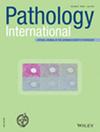Epidemiological study of the subtype frequency of systemic amyloidosis listed in the Annual of the Pathological Autopsy Cases in Japan
IF 2.5
4区 医学
Q2 PATHOLOGY
引用次数: 0
Abstract
Clinical presentation of systemic amyloidosis differs among subtypes, and accurate subtype classification is important for choosing the treatment. Amyloid transthyretin (ATTR) amyloidosis was the predominant among the recently consulted amyloidosis cases in Japan. To reveal the latest subtype frequency of systemic amyloidosis among autopsy cases in Japan. We analyzed systemic amyloidosis cases autopsied from January 2017 to December 2018, that were listed in the Annuals of the Pathological Autopsy Cases in Japan, Volumes 60 and 61. When the subtype was unclear, we performed a questionnaire survey, immunohistochemistry with in-house rabbit polyclonal anti-κ116–133, anti-λ118–134, and anti-transthyretin115–124 antibodies, and proteomic analysis. Out of 481 systemic amyloidosis cases listed in the Annuals, 411 cases were available for analysis (85.4%). We classified 399 of these systemic amyloidosis cases. ATTR was the most common subtype (44.4%, n = 177), followed by amyloid immunoglobulin light chain (AL) (38.8%, n = 155). Amyloid A and amyloid β2-microglobulin were 9.3% (n = 37) and 6.0% (n = 24), respectively. Double deposition of amyloid was identified in 1.6% (n = 6). In 168 cases (42.1%), systemic amyloidosis was the main cause of death. Of these cases, AL was the most common subtype (47.6%, n = 80), followed by ATTR (41.1%, n = 69). ATTR is the most predominant subtype among the current autopsy cases in Japan.日本病理解剖病例年鉴》所列全身性淀粉样变性亚型频率的流行病学研究
不同亚型的全身性淀粉样变性临床表现不同,准确的亚型分型对选择治疗方案至关重要。在日本最近咨询的淀粉样变性病例中,淀粉样转甲状腺素(ATTR)淀粉样变性占主导地位。揭示日本尸体解剖病例中系统性淀粉样变的最新亚型频率。我们分析了2017年1月至2018年12月解剖的系统性淀粉样变病例,这些病例列在《日本病理解剖病例年鉴》第60卷和61卷中。在亚型不明确的情况下,我们进行了问卷调查,免疫组化检测了兔抗κ116 - 133、抗λ118 - 134和抗转甲状腺视黄酮115 - 124抗体,并进行了蛋白质组学分析。在年鉴中列出的481例全身性淀粉样变性病例中,有411例可供分析(85.4%)。我们对其中399例系统性淀粉样变进行了分类。最常见的亚型是ATTR (44.4%, n = 177),其次是淀粉样免疫球蛋白轻链(AL) (38.8%, n = 155)。淀粉样蛋白A和淀粉样蛋白β2微球蛋白分别为9.3% (n = 37)和6.0% (n = 24)。淀粉样蛋白双重沉积1.6% (n = 6)。168例(42.1%)中,全身性淀粉样变性是主要死亡原因。AL是最常见的亚型(47.6%,n = 80),其次是ATTR (41.1%, n = 69)。在日本目前的尸检病例中,ATTR是最主要的亚型。
本文章由计算机程序翻译,如有差异,请以英文原文为准。
求助全文
约1分钟内获得全文
求助全文
来源期刊

Pathology International
医学-病理学
CiteScore
4.50
自引率
4.50%
发文量
102
审稿时长
12 months
期刊介绍:
Pathology International is the official English journal of the Japanese Society of Pathology, publishing articles of excellence in human and experimental pathology. The Journal focuses on the morphological study of the disease process and/or mechanisms. For human pathology, morphological investigation receives priority but manuscripts describing the result of any ancillary methods (cellular, chemical, immunological and molecular biological) that complement the morphology are accepted. Manuscript on experimental pathology that approach pathologenesis or mechanisms of disease processes are expected to report on the data obtained from models using cellular, biochemical, molecular biological, animal, immunological or other methods in conjunction with morphology. Manuscripts that report data on laboratory medicine (clinical pathology) without significant morphological contribution are not accepted.
 求助内容:
求助内容: 应助结果提醒方式:
应助结果提醒方式:


